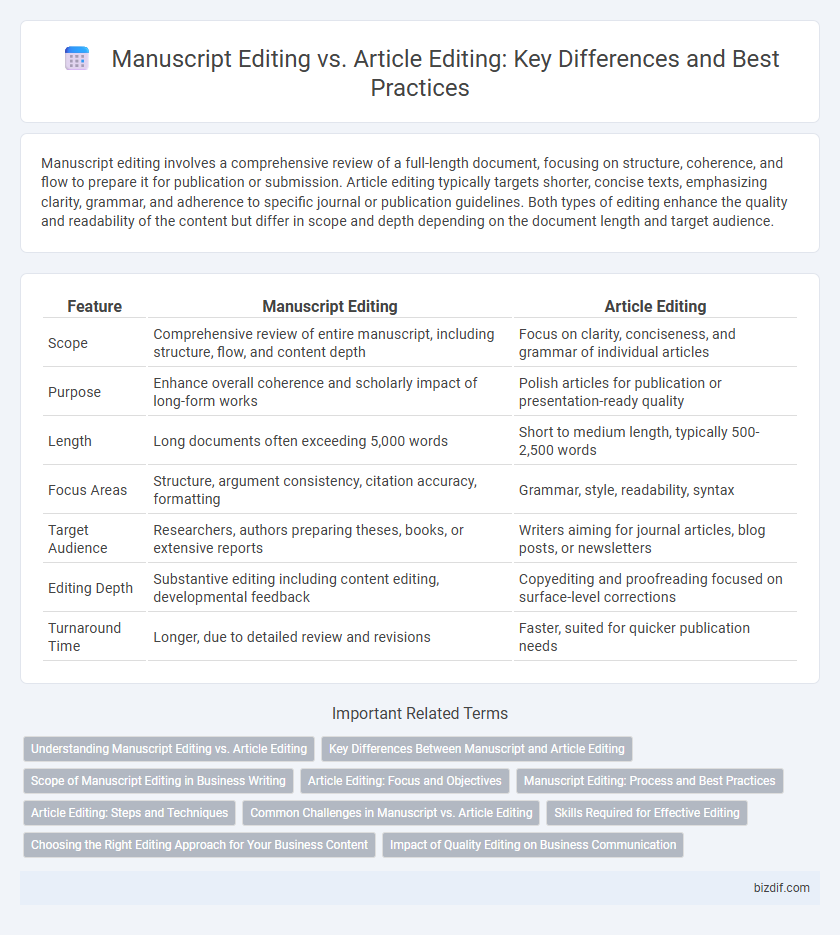Manuscript editing involves a comprehensive review of a full-length document, focusing on structure, coherence, and flow to prepare it for publication or submission. Article editing typically targets shorter, concise texts, emphasizing clarity, grammar, and adherence to specific journal or publication guidelines. Both types of editing enhance the quality and readability of the content but differ in scope and depth depending on the document length and target audience.
Table of Comparison
| Feature | Manuscript Editing | Article Editing |
|---|---|---|
| Scope | Comprehensive review of entire manuscript, including structure, flow, and content depth | Focus on clarity, conciseness, and grammar of individual articles |
| Purpose | Enhance overall coherence and scholarly impact of long-form works | Polish articles for publication or presentation-ready quality |
| Length | Long documents often exceeding 5,000 words | Short to medium length, typically 500-2,500 words |
| Focus Areas | Structure, argument consistency, citation accuracy, formatting | Grammar, style, readability, syntax |
| Target Audience | Researchers, authors preparing theses, books, or extensive reports | Writers aiming for journal articles, blog posts, or newsletters |
| Editing Depth | Substantive editing including content editing, developmental feedback | Copyediting and proofreading focused on surface-level corrections |
| Turnaround Time | Longer, due to detailed review and revisions | Faster, suited for quicker publication needs |
Understanding Manuscript Editing vs. Article Editing
Manuscript editing involves comprehensive revision of entire documents, including structure, coherence, and content accuracy, tailored to authors preparing books, theses, or lengthy reports. Article editing focuses on refining shorter academic or journal articles, emphasizing clarity, conciseness, grammar, and adherence to specific publication guidelines. Both editing types require specialized skills but differ fundamentally in scope, target audience, and editorial depth.
Key Differences Between Manuscript and Article Editing
Manuscript editing involves comprehensive structural revisions, clarity improvements, and consistency checks, often addressing extensive research content aimed at book publication or academic submissions. Article editing focuses on concise content refinement, adherence to journal-specific guidelines, and enhancing readability for shorter, peer-reviewed publications. Key differences include the scale of editing, target audience, and formatting requirements, with manuscript editing demanding a broader scope and article editing prioritizing precision and conformity to publication standards.
Scope of Manuscript Editing in Business Writing
Manuscript editing in business writing encompasses comprehensive refinement of structure, clarity, tone, and consistency to ensure the document effectively communicates its purpose to stakeholders. Unlike article editing, which often targets brevity and audience engagement for publication, manuscript editing addresses detailed content organization, factual accuracy, and alignment with corporate branding standards. This broad scope includes enhancing executive summaries, proposals, reports, and white papers to meet professional quality and strategic objectives.
Article Editing: Focus and Objectives
Article editing prioritizes clarity, coherence, and adherence to publication standards to ensure the manuscript meets journal-specific requirements and engages the target audience effectively. It involves refining the language, structure, and argument flow while enhancing the article's impact and readability. Manuscript editing, by contrast, may be broader, addressing foundational content and overall organization before detailed article-level polishing.
Manuscript Editing: Process and Best Practices
Manuscript editing involves comprehensive evaluation and refinement of content, structure, and language to enhance clarity, coherence, and academic rigor. The process includes developmental editing to organize ideas, copyediting for grammar and style consistency, and proofreading to eliminate typographical errors. Best practices emphasize understanding the target journal's guidelines, maintaining the author's voice, and ensuring compliance with ethical standards to prepare a polished submission-ready manuscript.
Article Editing: Steps and Techniques
Article editing involves a systematic process of reviewing structure, clarity, and flow to ensure the content effectively conveys the intended message. Key techniques include checking for coherence, refining sentence structure, eliminating jargon, and enhancing readability to meet publication standards. Editors also verify citation accuracy and adherence to style guides to optimize the article for its target audience and platform.
Common Challenges in Manuscript vs. Article Editing
Manuscript editing often involves addressing extensive structural issues, such as ensuring logical flow between chapters and verifying consistency across large sections, which can be challenging due to the document's length and complexity. Article editing focuses more on refining clarity, coherence, and conciseness within a limited word count, demanding precision in language and adherence to journal-specific formatting guidelines. Both processes require meticulous attention to detail, but manuscripts often present greater difficulties in maintaining thematic unity and addressing comprehensive content revisions.
Skills Required for Effective Editing
Manuscript editing demands strong skills in structural organization, comprehensive content evaluation, and consistency to ensure a coherent narrative throughout the entire text. Article editing requires expertise in clarity, conciseness, and adherence to specific journal guidelines, emphasizing precision and readability within a limited word count. Both types of editing benefit from attention to grammar, style, and factual accuracy, but manuscript editing often involves a deeper, more extensive revision process.
Choosing the Right Editing Approach for Your Business Content
Manuscript editing involves comprehensive review and refinement of entire documents, ensuring structural coherence, narrative flow, and detailed content accuracy, ideal for books and extensive reports. Article editing centers on enhancing clarity, conciseness, and engagement in shorter pieces, such as blog posts or journal submissions, optimizing them for target audiences and publication standards. Selecting the right approach depends on the document's length, purpose, and desired outcome, aligning editing scope with business goals to maximize content impact.
Impact of Quality Editing on Business Communication
Manuscript editing enhances comprehensive content structure, clarity, and coherence, ensuring that complex ideas resonate effectively with target audiences. Article editing focuses on precision, style consistency, and adherence to publication standards, maximizing reader engagement and credibility. High-quality editing in both formats significantly elevates business communication by fostering professionalism, reducing misunderstandings, and driving stronger stakeholder trust.
Manuscript Editing vs Article Editing Infographic

 bizdif.com
bizdif.com